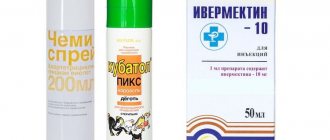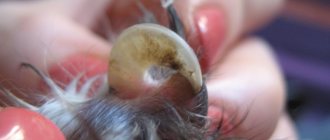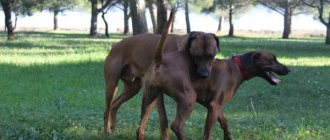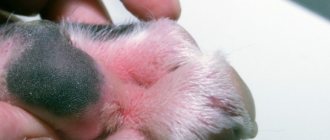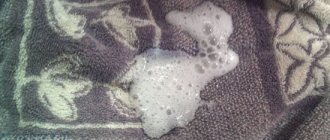Characteristic symptoms
Pododermatitis in dogs can be caused by diseases of different nature.
They determine the main symptoms of the disease. An infectious or fungal disease can manifest itself as inflammation, redness of the pads and interdigital spaces, and the formation of pustular lesions and ulcers. Temperatures in this area are likely to rise slightly.
In case of a contact allergic reaction that occurs after walking on asphalt sprinkled with salt or a chemical reagent, severe itching is added to the inflammation and redness, which greatly worries the dog. The hair on the paws may fall out.
A general allergic reaction manifests itself with the same symptoms, but they affect not only the paws, but also other parts of the body (face, ears).
Autoimmune pododermatitis is the most difficult form of the disease to diagnose. To recognize it, you will need to conduct a lot of examinations. Symptoms are the same as for other forms of the disease. In addition, the skin on the paw pads may darken and thicken.
Swelling and redness of the skin in the interdigital spaces indicate hormonal and endocrine disorders.
Oncological pododermatitis is the most dangerous type. It is characterized by the appearance of compactions, neoplasms, and ulcers.
Inflammation of the tissues of the arch and interdigital space in dogs
Occurs for the same reasons as the previous disease. It often develops in dogs with naturally wide-spread paws and flat feet. Another reason is the dog’s hypothermia due to being tied for a long time on damp soil or a wet cement floor. Symptoms: noticeable lameness, redness, swelling, in case of complications - purulent inflammation, ulcers, eczema.
Treatment
The treatment is antiseptic in nature, similar to the treatment of inflammation of the corolla of the claw. If the damage is significant, bandages with an antiseptic are placed on the paw or special protective shoes are worn.
Video - Skin diseases in dogs
Treatment options
There is no general scheme for treating pododermatitis in dogs. In each case, an individual approach is important.
Treatment tactics depend on the diagnostic results. The goal is to combat the causative agent of the underlying disease.
Based on the examination results, the following treatment may be prescribed:
- treatment of affected areas with antiseptic agents;
- antibacterial therapy;
- surgical intervention;
- antifungal therapy;
- antihistamines;
- dietary nutrition;
- lifelong maintenance therapy.
The choice of treatment method depends on what type of pododermatitis (type of inflammation) you are experiencing.
Aseptic pododermatitis
It manifests itself as a persistent inflammatory process and pain syndrome. There is no purulent tissue damage. The main treatment is thorough treatment with antiseptic drugs. It is carried out by the owner himself.
Purulent pododermatitis
A disease complicated by purulent tissue infection. This species has pronounced symptoms: the dog groans in pain and the body temperature rises. Antimicrobial therapy is indicated for the treatment of purulent pododermatitis. And in severe cases, surgery may be required. The doctor opens the abscesses and rinses the cavities with an antiseptic and antibiotics.
Radial nerve palsy in dogs
This disease is the most common in comparison with lesions of other nerves in the extremities. Occurs due to bruises and muscle strain. After a mechanical injury to the radial nerve, the triceps brachii muscle ceases to function, and all distal joints become bent. Symptoms: extended shoulder joint, drooping elbow and bent wrist. The dog cannot lean on the limb due to its unnatural position.
Treatment
Daily massages can alleviate the patient's condition. Galvanization with iontophoresis, heating, and exposure to UV lamps are also prescribed. Darsonvalization of the radial nerve and daily injections with vitamins B1 and B2, Dibazol and Proserin are performed in alternation. The course of injections is 1 month.
Radial nerve palsy of the front paw in a dog
Why does the disease occur?
Interdigital dermatitis can appear under the influence of various factors.
- One of the common causes of the symptoms that can be seen in the photo below is mechanical damage to the skin. It can be caused by injury, irritation, scratching, or bruise. In this case, a traumatic form of dermatitis is diagnosed.
The disease appears due to physical or chemical influence on the surface of the skin. This may be contact with an irritant. It is characterized by itching, redness, swelling of tissues, and a blistering rash. When the negative factor is eliminated, the symptoms go away on their own. It is important to distinguish the disease from eczema, which is characterized by a chronic inflammatory process.
A common cause is an allergic reaction. It manifests itself in the area between the fingers under the influence of a large number of irritants.
Interdigital dermatitis can form due to bacterial infection. It is often caused by exposure to staphylococcal bacillus or candida type fungi.
Some dogs suffer from psychogenic dermatitis. It is formed when an animal experiences stress due to separation from its owner or moving.
The disease should be treated based on the causes of the rash.
There are many reasons why dogs develop interdigital dermatitis. >Treatment and prevention of disease
Treatment of the disease begins with determining the type of dermatitis. This can be done by a veterinarian during an examination of the dog and diagnostic procedures.
Eczema in dogs
Typical for hunting dogs. Appears on skin irritated by thorns, pine needles, and nettles. Due to damage, inflammation develops on the outer layers of the skin and a rash forms. Symptoms: a rash first appears in the form of blisters, which, when opened, form wet eczema. The inflammatory process can drag on for a long time. The dog has difficulty walking and his paw hurts.
Treatment
Initially, treatment is carried out against fleas, ticks and worms to exclude the parasitic nature of the infection. If present, the external irritant is eliminated - for example, if the cause is a reaction to the reagent used to cover the roads, the dog should wear special shoes.
Eczema on a dog's paw
Before treatment, the hair on the affected area is cut off. If the wound is dirty, it should be washed with a decoction of burdock, chamomile, oak, Chlorhexidine or a weak solution of manganese. Topical treatment is treatment with an eczema cream or spray that has:
- antifungal;
- antimicrobial;
- anti-inflammatory;
- wound healing;
- drying effects.
Weeping eczema is treated with a course of antibiotic injections or tablets. It is recommended to combine: start treatment with injections and end with tablets. Appointed:
- "Sinulox" 250: 12.5 mg/kg every 12 hours for 14 days;
- “Ciprofloxacin” 500: up to 2 tablets daily for 2 weeks, the dose depends on the complexity of the inflammation;
- "Amoxicillin", solution 15%: 1 ml/kg every 24 hours for 7 days or tablets - 15 mg/kg;
- "Erythromycin": 15-20 mg/kg every 24 hours for 14 days.
Ciprofloxacin tablets (dosage 500 mg)
To speed up wound healing for wet eczema and to renew the skin surface for dry eczema, vitamin and metabolic preparations are used:
- ascorbic acid, “Retinol” and “Tocopherol” 5% alternately 1 ml., one drug is given every day;
- “Vitam”: 3-5 ml/10 kg twice a week, leave for 30 days;
- “Gamavit”: 0.5 ml/kg 2-3 times weekly, also for a month; "Katozal": from 2.5 to 5 ml., the dose depends on the condition of the dog.
Solution for injections "Gamavit"
Important! These drugs are contraindicated in cases where the underlying cause is an allergic reaction. They can aggravate the patient's condition.
Causes and signs of the disease
Pododermatitis is not an independent disease. It develops as a result of diseases that weaken the body’s defenses and allow pathogenic microorganisms that have settled on the skin to begin to rapidly multiply. Inflammatory processes are accompanied by dermatitis and demodicosis, fungal infections and cancer, hypothyroidism, and injuries of various etiologies. The disease affects dogs in old age, too clean individuals who lick their paws excessively.
Signs of the disease include redness of the skin in the area of the paw pads and the space between the toes, inflammation and pain. Wounds and small ulcers, ulcers or fistulas may form on the affected areas. The paws of a sick animal may swell and increase in size, leading to lameness. At this time, the pet begins to diligently lick its limbs.
About the prevention of pododermatitis
This disease is insidious. Its treatment can be lengthy, and relapses are also possible. Therefore, every dog owner should take some steps to reduce the risk of it occurring. The owner needs:
Be attentive to your tailed friend every day and respond promptly to any changes in his physical and mental condition.
The expression “movement is life” is especially true for our pets. Only those dogs that take long walks every day maintain their health and well-being for a long time. But there are more than a dozen diseases in which an animal simply physically cannot frolic happily in the fresh air. One of them is pododermatitis in dogs.
This is the name for inflammation of the paw pads. What are the reasons for such an unpleasant phenomenon? There can be a lot of them: infections, allergies, hormonal disorders, autoimmune diseases, poor ecology (salt on city streets), oncology. Before visiting the veterinarian, it is advisable to know the answers to the following questions:
- Where does the dog live (city or countryside)?
- Do clinical signs appear constantly, or is the phenomenon seasonal?
- Are the lesions only observed on the paws, or can they be seen on other parts of the body?
- Have you tried home treatment?
- Has your dog's diet changed?
- Have you traveled anywhere recently?
- Does the dog have any other health problems?
The veterinarian’s choice depends on your exact answers: what to treat, what treatment regimen to use, how long it will take.
Cracks or broken claws
The problem appears if, after an injury to the paws or claws, the dog is not given timely help. The dog limps and whines when examined, and there is suppuration or a nail falling off in the paw. To avoid its complete loss, softening compresses with oil are made, and the claw is treated with antiseptics.
Treatment
It is eliminated by removing the cutting end of the nail or crack with a sharp knife, then the cut area is covered with epoxy resin. This way you can save your pet's claw. If the base of the claw is damaged, it is treated with an antiseptic, then dried and coated with iodine. Then the burrs and broken claws are cut off with scissors and coated with streptocide or a mixture of manganese and boric acid. Aerosols are also suitable - “Ungutil” or “Kubatol”. After treatment, a protective bandage is applied to the paw.
Aerosol "Kubatol"
Clinical picture
It is heterogeneous and depends on the root cause that caused the development of the disease. So, if there is some kind of infectious pathology, the pads and paws become noticeably red and may swell, and the local tissue temperature is increased. In these cases, you can see nodules (papules) or pustules, notice ulcers or discharge of pus (visible in the photo). If the disease is advanced, the animal’s legs often become bald.
What if pododermatitis has an allergic background? The skin on the paws is also red and swollen, but an increase in local body temperature is usually not recorded. The hallmark is severe itching, which causes the dog to constantly rub and lick its limbs. If interdigital pododermatitis in dogs develops as a result of an allergy, then the dog can spend hours rubbing its paws in its mouth. As a result, the skin on them becomes macerated, and massive hair loss begins. The remaining fur on the paws is all sticky and important from a large amount of saliva.
Please note: if you are dealing with a contact variant of the disease that has arisen as a result of direct contact with allergens or toxic substances, then the lesions are fixed on the paw pads themselves. When the cause is a general allergic reaction, then signs of pathology are visible not only on the paws, but also on the face, as well as the ears.
Bruises and wounds of paw pads in dogs
Typical for hunting and service dogs. Occurs due to a long run over rough terrain, frozen ground, icy snow, or a road with coarse sand. Symptoms include the dog’s refusal to move; when walking, the animal does not want to lean on a limb. Abrasions, wounds and scratches are noticeable on the pads; burns are possible due to contact with lime, boiling water, acid or alkali. Severe cases are characterized by skin sloughing and non-healing ulcers.
Treatment
The dog needs complete rest. Before treatment, the paw is examined for the presence of foreign bodies - large splinters, pieces of glass or wire. Foreign bodies are removed, and the wound is surgically cleaned of infection. Then an antiseptic bandage is applied.
If the cause of the disease is abrasions, treatment with antiseptic aerosols - Chronicilin and Kubatol - is prescribed. Treatment with Streptocide or Xeroform under a protective bandage is possible. In cases of severe pain, a cold compress is applied to the paw.
Abrasions on a dog's paw
Causes
According to experts, the following infections most often provoke pododermatitis in dogs:
- Proteus;
- staphylococcus;
- streptococci;
- Pseudomonas aeruginosa;
- cryptococcosis;
- blastomycosis.
In addition, many pathogenic fungal infections cause pododermatitis.
The autoimmune form occurs against the background of:
- vasculitis;
- erythema;
- lupus erythematosus;
- epidermal necrolysis.
A rather rare type of pathology is plasmacytic pododermatitis, however, it most often affects cats.
Hormonal reasons are as follows:
- Cushing's disease (hypercortisolism);
- hypothyroidism
Dysfunctional liver disorders also lead to pododermatitis.
Of the oncological diseases, the pathology in question is caused by:
- exocrine adenocarcinoma;
- melanoma;
- inverted papilloma.
External negative factors are mainly limited to contact with chemicals used in winter to destroy ice. In addition, jogging on asphalt is also harmful to dog paws.
Signs
Symptoms differ depending on the etymology. The infectious form is accompanied by:
- redness;
- swelling;
- inflammation;
- papules;
- ulcerations;
- ulcers.
In advanced forms, baldness of the legs is noted.
Allergic pododermatitis is accompanied by the following symptoms:
- swelling;
- redness (without local increase in temperature);
- severe itching.
The autoimmune form is accompanied by the appearance of ulcers on the entire surface of the paws.
Hormonal pododermatitis manifests itself in the same way as infectious ones.
Paw diseases in large breed dogs
For large, heavy dogs, paw disease is not uncommon. Due to their heavy weight, their joints often hurt. The cause can be not only acquired diseases, but also congenital ones. The most common are:
Hip dysplasia
Children often experience hip dysplasia, a disease that is inherited. It is diagnosed in dogs during the period of intensive growth - from 4 to 10 months. It becomes difficult for puppies to get up after sleep; they limp for a long time. If left untreated, the symptoms intensify, and the four-legged animal faces complete immobilization.
Visual representation of hip dysplasia
Treatment
It will not be possible to completely rid your pet of dysplasia, but you can alleviate his condition. Treatment can be conservative or surgical.
For conservative treatment, medications are prescribed:
- anti-inflammatory (“Rimadyl”, “Quadrisol-5”, “Deracoxib”);
- painkillers (“No-spa”, “Phenylbutazone”, “Ibuprofen”, “Acetylsalicylic acid”);
- chondroprotectors (“Pentosan”, “Chondrolone”, “Stride”, “Adequan”);
- supplements and vitamin-mineral complexes with chondroitin and glucosamine.
Dosages are prescribed depending on the degree of neglect of the disease and the condition of the animal. Physiotherapy also helps well - massage, ozokerite, laser and paraffin therapy.
Surgery is necessary when the disease progresses and the dog gets worse. The operation involves adjusting the shape of the femoral head: it is done to the size of the acetabulum. Depending on the complexity of the case, partial removal of the cartilage or replacement of the damaged area with a titanium prosthesis is performed.
Hip dysplasia
After surgery, with proper care, complete restoration of the joint is possible, and the dog will be able to move independently.
Arthritis
With arthritis, an inflammatory process begins in the dog's joints, which interferes with normal walking and causes severe pain. It most often affects the elbow or hip joint. Due to illness, the dog moves little, limps, and does not want to go outside. Therapy is prescribed only after examination and identification of the cause of the pathology. The veterinarian takes an x-ray of the affected area, and in rare cases, an analysis of fluid from the diseased joint is required.
Arthritis in a dog
Treatment
The basis is treatment with medications in the following areas:
- Anti-inflammatory, analgesic: “Onsior”, “Metacam”, “Rimadyl”. Relieve pain and inhibit the spread of inflammation. In the absence of these drugs, aspirin is suitable, but only for short-term therapy.
- Antibiotics in cases where the root cause of the disease is pathogenic bacteria.
- Chondroprotectors (Chondrocan, Chondroitin complex, Chondartron, Chondrolon) to restore damaged cartilage, strengthen and protect against infection.
For a speedy recovery, the dog is recommended to do health-improving exercises; swimming, massage and physiotherapy are also prescribed.
Arthritis on a dog's front leg
Arthrosis
A joint disease that often becomes chronic and does not have an inflammatory nature. It is characterized by deformation of the joints and can be diagnosed by the crunching of bones that is heard when walking.
Treatment
As treatment, medications are prescribed to relieve inflammation and pain. They are used as intramuscular or intraarticular injections. This:
- "Ibuprofen";
- "Gamavit";
- "Voltaren";
- "Vedaprofen";
- "Quadrisol-5".
Bones from the inside with arthrosis
To quickly restore cartilage in joints and increase resistance to infections, chondroprotectors with glucosamine and chondroitin are prescribed. Cold salt lotions, warming compresses with paraffin and ozokerite, and wraps with herbal decoctions can alleviate the condition at the initial stage of arthrosis. But such therapy cannot replace full-fledged treatment.
Hygroma of the elbow
It is a collection of fluid in the elbow joint. In the chronic stage, the disease becomes serous in nature. The size of the elbow increases significantly. The sinus filled with fluid can grow to the size of a chicken egg. Usually the disease does not cause any pain, only discomfort.
Table 3. Treatment of elbow hygroma
| Conservative treatment | Surgical treatment | |
| Troubleshooting | With a simple hygroma, the problem is solved by sucking out the fluid from the cavity, after which a corticosteroid is injected into the “bag” on the olecranon. This could be Diprospan 2-4 mg with 1-2 ml of Lidocaine 2% solution | In more complex cases, the affected cavity is drained using glove or passive drainage. To prevent the infection from spreading, for the first 5 days after surgery, fluoroquinolone antibiotics are prescribed and the cavity is disinfected with Dioxidin 1% daily for a week |
| Recovery | If the dog's condition improves, it is enough to give 1-3 injections with an interval of 18-60 days. In case of relapse, a repeat course of Diprospan is prescribed. | If purulent discharge is observed after drainage, the veterinarian will prescribe antibiotics depending on the color and consistency of the discharge. After 1-1.5 months, the drainage is completely removed |
Hygroma of the elbow in an advanced stage
How to treat
If the lesions are isolated, then it is usually not difficult to cope with them with the help of antiseptic drugs.
- Chlorhexidine;
- Streptocide ointment;
- Tetracycline.
Antibiotics are not prescribed if there is mild interdigital pododermatitis. Paws should be washed regularly with warm water and soap.
Multiple lesions require a different approach. First of all, it is necessary to begin treatment of the underlying disease. Here antibacterial therapy is advisable. Moreover, the drugs are taken until all symptoms disappear and for another 14 days after that. It is mandatory to clean the skin between the fingers several times a day.
It will take a lot of time to cure a dog. It is worth understanding that sometimes there is a risk of relapse. As a rule, the progression of the disease occurs more often in winter due to the fact that the paws remain wet for a long time, which creates an ideal environment for microbes.
At home, veterinarians advise applying compresses of antiseptic herbal mixtures to sore paws - this helps relieve itching and pain.
Symptoms of paw disease in dogs
First of all, obvious symptoms appear that clearly indicate that the paw is not in order. This:
- lameness;
- the desire to move less and lie more;
- clumsy walking, the pet whines, stepping on the damaged paw;
- the dog's attempts to strain the sore paw as little as possible.
Then other symptoms appear, which depend on the characteristics of the disease. For example, the owner notices that the dog begins to chew its paw. This may be caused by:
- poor hygiene and condition of nails;
- joint pain;
- numbness of fingers;
- allergies, itching or tick bites;
- fungal diseases.
The desire to move less and lie more is one of the signs of an unhealthy dog
Causes
Pododermatitis is an inflammation of the outer tissue of the limbs. It can be infectious (the penetration of a bacterial infection) or aseptic (mechanical damage) in nature. The pathology causes significant discomfort to the dog and can cause lameness. In advanced forms, inflammation spreads to other tissues.
The disease occurs in areas of the limbs that come into contact with the ground. Basically, localization is noted on the paws in the space between the toes and on the pads. Also, the inflammatory process can spread to the nail bed, which in the future leads to loss of the claw.
Pododermatitis itself is not an independent disease. It develops against the background of certain pathologies that lead to a decrease in the body’s protective functions - weaken the immune system. Provoking factors may be:
- immunological disorders (thrombocytopenia, periarteritis nodosa, systemic lupus erythematosus);
- fungal skin infection (mycosis);
- the presence of parasites (helminths, ticks, fleas, etc.);
- contact with an allergen;
- endocrine disorders and metabolic diseases (hypo- and hyperthyroidism, hypercortisolism, diabetes mellitus);
- oncological pathologies (negatively affecting the entire body, regardless of the location of the primary focus, blocking the functioning of the immune system).
In addition to internal pathologies, pododermatitis can develop against the background of mechanical damage to the skin:
- with injury to the paw pad;
- with prolonged contact of the paws with a rough surface (for example, asphalt), which causes irritation and cracks in the pads;
- when the paw is injured by a sharp or prickly object.
There is also a genetic predisposition to pododermatitis. This pathology is most often observed in dogs of the following breeds:
- Labrador;
- Doberman;
- Dalmatian;
- Shar Pei;
- dachshund.
Hind leg failure in dogs
The hind legs fail in case of complications of diseases. These may be the consequences of arthritis, arthrosis, tumors, intervertebral hernia. Neurological diseases, injuries, and problems in the gastrointestinal tract can also be causes. The pet's hind legs may fail due to radiculitis and pyelonephritis. If your dog's hind legs begin to function poorly, you should go to the veterinarian. Timely therapy will help restore mobility. Otherwise, everything may end in complete paralysis of the paws.
Hind leg failure in a shepherd puppy
Treatment
After examination and identification of the root cause, therapy is prescribed. It could be:
- The use of painkillers for acute pain syndrome.
- Anti-inflammatory drugs: Quadrisol, Rimadyl. They are applied to the inflamed area after pain has been relieved or reduced.
- A course of B vitamins to restore the transmission of nerve impulses. Contraindicated in the presence of tumors.
- The drug "Prozerin" for restoring muscle tone and conductivity of the nervous system.
- Preparations "Fervistim", "Fervital" for concomitant damage to the gastrointestinal tract. Eliminate constipation, restore bowel and bladder functions.
- Acupuncture and massages help to return motor activity. These methods are used only in the absence of pain.
- Surgical intervention in cases where the legs fail due to compression of the vertebrae by a hernia or tumor.
Release form of the drug "Rimadyl"
Important! It is not recommended to start treating your pet on your own. Depending on the nature of the disease, the veterinarian should prescribe individual therapy.
Symptoms
Pododermatitis affects the dog's limbs and causes significant difficulty in moving. The dog will limp and try not to lower its paw. The disease can progress and affect several limbs, which makes the situation worse.
When the first signs of illness appear, the owner should carefully examine the animal’s paws. If your dog shows signs of pododermatitis, you should contact your veterinarian as soon as possible.
The main symptoms of the pathology are:
- lameness (if several limbs are affected, the animal will experience significant difficulties in moving);
- redness of the skin between the toes and on the pads of the paws;
- dry skin;
- the presence of wounds on the skin of the interdigital spaces and pads;
- the appearance of blisters with purulent or bloody contents.
Over time, swelling of the limb may occur. The affected areas will be tender and painful. The dog may withdraw its paw when the sore area is touched. She may constantly lick her paw in an attempt to relieve the pain and itching, but this will only irritate the skin further.
If you have characteristic symptoms, you should not postpone your visit to the doctor. This condition causes severe discomfort for the dog, so treatment must be started immediately.
Diseases by location
There is a classification of diseases according to location, which makes it possible to quickly make a diagnosis and begin treatment.
Front legs
Having noticed that the pet has begun to limp on its front legs, owners should conduct a thorough examination, which will help identify the causes of this symptom.
- Cuts, splinters or soft tissue burns. With these pathologies, lameness begins to appear suddenly during a walk. When cutting the fingertips, there is always heavy bleeding, since this area has a well-developed network of blood vessels. You can stop the bleeding by applying a tourniquet or tight bandage slightly above the wrist joint.
Note! If, after a cut, the dog cannot lean on its paw and at the same time strongly bends it under itself, then this indicates damage to the ligaments. Unfortunately, complete dissection of the ligaments does not recover on its own, and even surgical treatment does not guarantee a 100% result.
The presence of a burn is indicated by a change in the color and structure of the top layer of tissue on the crumbs. The affected area should be treated first with an antiseptic solution (Chlorhexidine), then with Panthenol and apply a sterile bandage. If there is severe pain, you can apply a few drops of anesthetic (novocaine, lidocaine) to the wound.
Important! In case of chemical burns, do not wash the affected surface with water. Acids should be neutralized with a solution of baking soda (5 g of soda per 0.5 liter of water), and alkalis with a weak solution of acetic acid. After this, thoroughly rinse off the remaining substance with water.
- Sprains, dislocations or fractures resulting from an unsuccessful jump, fall or compression. These pathologies are accompanied by very severe pain. The animal cannot stand on the affected limb. The paw becomes hot, swollen, sometimes deformed or hanging lifelessly. Only a veterinarian can make an accurate diagnosis and provide qualified assistance.
- Claw injuries. A nail broken at the root causes severe pain to the pet and causes lameness. You should not try to remove the remains of the damaged plate yourself, as this can lead to bleeding and cause severe pain.
- Ingrown nails. In dogs that rarely walk outside, the nail plate does not naturally wear off, and its sharp edge, bending, grows into the pad of the finger. The pet cannot fully step on its paw, twists it, limps and tries to get rid of the source of pain. Treatment is surgical excision followed by antiseptic treatment, carried out only by a veterinary specialist.
- Arthritis, arthrosis. Deformation of the articular surfaces is accompanied by limited mobility of the animal, lameness, pain and enlargement of the joints, which produce a characteristic crunch when walking.
- Elbow dysplasia. Degenerative changes in joint tissues lead to the development of lameness, the appearance of a painful syndrome, an increase in joint volume, and stiffness of movement.
- Osteosarcoma. Cancerous lesions of the bone tissue of the forelimbs in the initial stage do not manifest clinical symptoms. As the malignant tumor grows, progressive pain, swelling, and limited mobility of the nearby joint appear. If left untreated, spontaneous bone fractures may occur as a result of thinning bone tissue. Surgical treatment consists of excision of the tumor. Subsequent therapy is aimed at preventing metastasis and relapse of the disease.
- Radial nerve palsy. The cause of the development of pathology is bruises, inflammation, and fractures of the bones of the shoulder girdle. At rest, the pet keeps its paw in a semi-bent state, and when walking, it jerks it forward. With complete paralysis, stepping on the front limbs becomes impossible.
Hind legs
Diseases of the hind legs are provoked by injuries, degenerative changes in bones and joints, infectious agents and hereditary factors.
- Injuries to the bones of the hind limbs and pelvis. Pathologies arise as a result of blows, squeezing, falling, gunshot and knife wounds. During treatment, a splint, plaster cast, or surgery using osteosynthesis is applied to the damaged paw.
- Sprains and ligament tears. The cause may be excessive physical exertion and unsuccessful landings after jumping. Clinical manifestations include lameness, tenderness to pressure, and small subcutaneous hemorrhages or hematomas. In the first hours, a cold compress is applied to the damaged area, local and general anesthetics are used, and the pet’s movement is limited. Subsequently, the doctor may prescribe physiotherapeutic procedures.
- Arthritis, arthrosis and dysplasia of the joints of the hind limbs. An effective treatment is joint replacement surgery. Conservative methods using anti-inflammatory drugs and chondroprotectors provide temporary relief and help slow down the destruction process.
- Sciatic nerve palsy . The causes are injuries to the soft tissues of the hind limbs, fractures of the pelvic bones, exposure to infectious agents and toxic substances, long-term pinched nerves, diseases of the brain and spinal cord. Partial paralysis is manifested by stiffness of gait, arching of the back, and gradual loss of sensitivity in the affected area. With complete paralysis, the animal moves only on its front legs. Even with correct and timely treatment aimed at eliminating the etiological factor, the prognosis remains cautious or unfavorable
- Dislocation of the kneecap. It is registered in representatives of all breeds, but is more common in Yorkies, miniature poodles and Chihuahuas. For this pathology, conservative treatment is ineffective. It only allows for short-term relief of pain and inflammation. With the help of surgical methods it is possible to completely cure the animal.
Paw pads
Diseases of the paw pads can be traumatic and inflammatory in nature.
- Cuts. Dissection of the soft tissues of the pads is accompanied by profuse bleeding. Significant blood loss can be prevented by applying a tight bandage to the paw and applying ice or any cold object.
- Penetration of sharp objects. If during a walk the dog suddenly yelps and begins to limp, then the cause may be a piece of glass, wood or metal stuck into the pad.
- Burns. Thermal skin damage occurs when a dog steps on hot objects, tar stains, hot asphalt or sand in the hot season. Chemical burns occur when paw pads come into contact with acids, alkalis, solvents, or quicklime.
- Pododermatitis. An inflammatory process that occurs on the paw pads as a result of allergic reactions, penetration of infectious agents, hormonal disorders, diabetes mellitus, autoimmune diseases, malignant growths and exposure to aggressive agents (salt, building mixtures, fuels and lubricants, etc.). Treatment is aimed at relieving symptoms and eliminating etiological factors.
Between the toes
The cause of inflammation of the skin between the toes is interdigital dermatitis.
Causes and symptoms of the disease:
- mechanical damage - cuts, scratches, abrasions, punctures, presence of foreign objects;
- exposure to chemical agents - itching, hyperemia, swelling, small blisters filled with serous exudate;
- allergic reaction - severe itching, in which the dog constantly wets the affected surface with saliva and licks the affected surface, causing tissue maceration, the development of eczema and hair loss;
- bacterial infections - hyperemia, increased local temperature, formation of ulcers, pain;
- pathogenic fungi - hair loss, severe itching, peeling;
- demodicosis - the appearance of hairless areas with a bubble in the center, from which, when pressed, a drop of transparent exudate is released;
- skin parasites - severe itching, scratching, rash, redness;
- stress factor - itching, rash, hyperemia.
Note! If the dog tries to gnaw something between the toes, then a thorough examination should be carried out for the presence of a foreign body or ixodid ticks. If parasites are detected, you must go to the clinic and donate blood for piroplasmosis.
Skin diseases
There is an impressive list of skin diseases that affect the limbs of dogs. They have both common and distinctive symptoms that make it possible to identify the pathology:
- trichophytosis and microsporia - itching, peeling, hair loss or breaking off;
- pityrosporosis (caused by the yeast Malassezia pachydermatis) - the appearance of hairless, weeping areas at the base of the nail, emitting an unpleasant putrid odor and itching;
- flea dermatitis - rash, itching, scratching;
- allergic reactions - itching, redness, swelling;
- pyoderma - pustular rashes, increased local temperature, hyperemia, itching;
- seborrhea - excessive peeling, severe itching, dry and brittle nails, hyperemia, hyperkeratosis of the fingers;
- sarcoptic mange - constant severe itching, rash on the elbow and hock joints, turning into bursting blisters, scales and dried crusts, the appearance of alopecia;
- Oncological dermatitis is a painless growth of tissue in the form of ulcers, nodules, bumps, erosions or rashes.
Treatment is prescribed by a veterinarian depending on the symptoms and individual characteristics of the pet’s body.
Joint diseases
The classification of diseases of the joints of the extremities includes pathologies of a degenerative, inflammatory, infectious and traumatic nature. Each disease is manifested by corresponding symptoms:
- arthrosis - increased and impaired joint mobility, crunching during movement, pain at the last stage of development;
- osteoarthritis - lameness and pain, worsening after sleep, increasing powerlessness and immobility over time, caused by severe pain in deteriorating joints;
- purulent arthritis - general depression, fever, pain and enlargement of the joint, decreased appetite or refusal to feed, lameness;
- hemarthrosis (joint hemorrhage as a result of injury) - pain, smoothing of the joint relief, severe lameness, increased local temperature, fever;
- dislocations - pain, swelling and increased temperature in the area of the affected joint, limited mobility, unnatural position of the limb;
- hip dysplasia - stiffness of movement, pain, wobbling gait;
- dysplasia of the elbow joints - problems when climbing stairs, pain and increased volume of the joints, lameness;
- joint wounds - violation of the integrity of the skin, soft tissues, synovial bursa and other anatomical structures of the joint, purulent inflammation (if the wound becomes infected);
- aseptic synovitis - hot swelling in the joint area, hyperemia, pain of varying intensity;
- infectious synovitis - acute pain accompanying purulent melting of joint tissues, fever, blocking limb mobility, hyperemia (if left untreated, sepsis develops and death occurs);
- traumatic synovitis - hemorrhages on the skin in the area of the injured joint, swelling filled with blood exudate, increased local temperature, pain.
As treatment, the doctor prescribes analgesics and anti-inflammatory drugs. If the integrity of the joints is violated or degenerative changes form in them, surgical treatment is used. In the presence of infectious processes, antibiotic therapy is necessarily prescribed.
Claw diseases
Claw diseases often affect sedentary and sick pets whose nail plates do not wear off naturally.
Important! Only an experienced specialist should trim nails, since without knowing the anatomical location of the neurovascular bundle located inside the plate, you can cause severe pain to your pet and cause heavy bleeding.
There are a number of other claw diseases.
- Ingrown nail. Excessively grown nails, bending, dig into the pads of the paws, pierce the top layer of skin and grow into soft tissues. The pain syndrome intensifies when pathogenic microflora enters the wound, causing purulent inflammation. Treatment involves surgical excision of a section of the nail plate and treatment of the wound with an antiseptic drug.
- Felon. Purulent inflammation of the nail rim, resulting from infection of damaged tissue. In order to prevent the development of sepsis, the veterinarian makes a puncture, applies a bandage moistened with an antiseptic, and additionally prescribes treatment with antibacterial ointments. In advanced forms of panaritium, surgical excision of the affected tissue is required, and in case of threat of sepsis, amputation of the phalanx is required.
- Claw injuries. Cracks and breaking of the nail plates cause severe pain and can cause bleeding. The damaged nail must be carefully trimmed with nail clippers, treat the wound with antiseptic ointment and apply a bandage. If the nail breaks off completely and there is heavy bleeding, you should contact a veterinary clinic.
- Fungal infections. Pathogenic fungi cause peeling of nails and excessively rapid death of the stratum corneum. The adjacent skin is gradually affected and the nail matrix is destroyed, causing it to fall off. Treatment with antifungal and anti-inflammatory ointments is used as treatment. In case of advanced infection, antimycotics are prescribed in tablets.
The cause of claw delamination can be autoimmune diseases and vitamin deficiencies in the diet. In this case, only a veterinarian can correctly diagnose and select therapeutic methods.
Diagnostics
The diagnosis of “pododermatitis” is established based on the clinical picture. The doctor will examine the dog and evaluate the condition of the affected area. If typical symptoms are present, an appropriate diagnosis will be made.
Since pododermatitis is a secondary pathology, it will be necessary to conduct a series of examinations to identify the true cause. This must be done so that during the treatment process not only the clinical manifestations are stopped, but the disease is eliminated completely or brought under control.
During the diagnostic process, the following examinations may be prescribed:
- blood and urine tests;
- cytological examination;
- scraping for demodicosis and determining the presence of other skin parasites;
- research to identify helminths;
- determining the presence of a fungal infection;
- allergy tests.
Additionally, specific blood tests may be prescribed to identify metabolic or immunological pathologies. You may need to consult a veterinary endocrinologist to rule out pathologies of the internal secretion organs.
